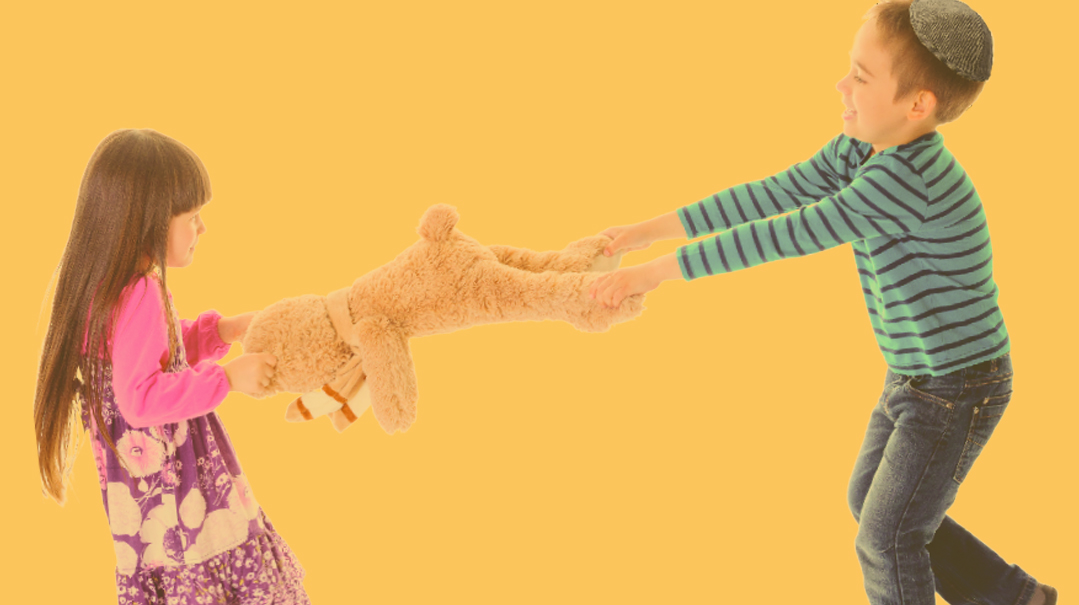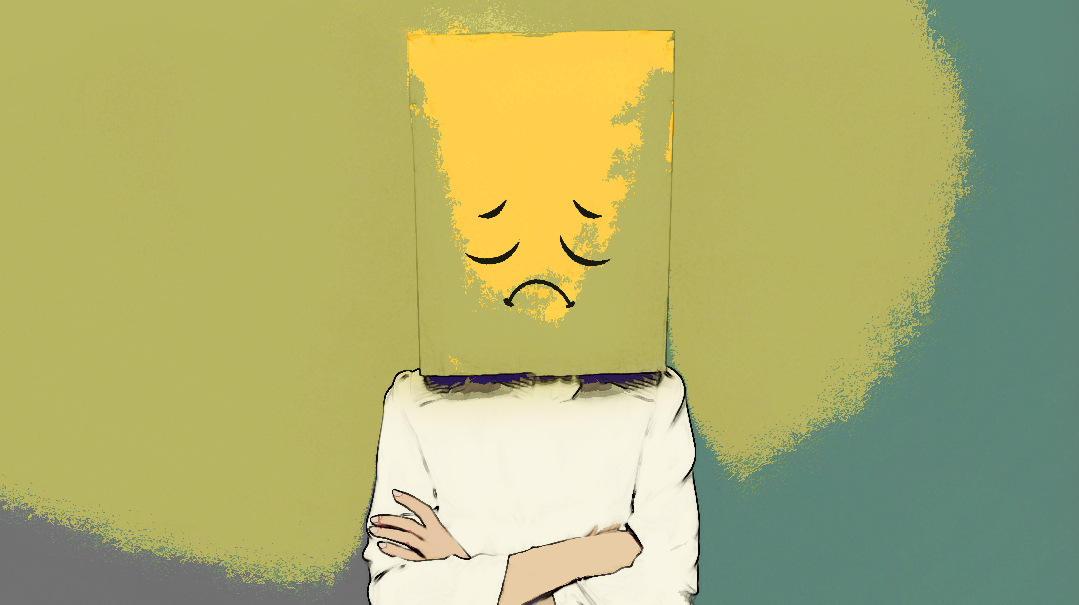Fighting Chance
| January 6, 2021Break up the bickering, and take your home from battlefield to haven

Goals: Maslow's Hierarchy of Needs
Tools used: to reduce the sibling rivalry in HIndy's home
When Hindy called me one frosty January evening, I heard desperation in her voice. It sounded loud and frenetic in the background. She said she was calling in regards to her children, but couldn’t elaborate on the phone. I put her on my cancellation list for the earliest possible session as she said it was urgent.
The following week, Hindy arrived at my office five minutes late. She seemed harried and distracted as she took a seat.
I explained the intake process to Hindy and waited as she filled out the forms. When she finished signing the necessary documents, she looked at me and burst into tears. Horrified, she quickly grabbed a tissue and tried to gather herself together.
My heart constricted as I watched Hindy remove her glasses, swipe her eyes, and finally meet my gaze.
“I feel terrible,” she whispered.
I spoke softly. “It looks like you’re holding a lot of pain, Hindy.”
“I feel that I’m failing my kids. I can’t do it anymore,” she said.
“Do what?” I gently asked.
“The day-to-day is very hard with them. My husband helps, but he works a lot and learns at night. It’s mostly just me at home, and I’m failing my kids.”
“In what way?”
“The kids fight nonstop with each other. Like brutal fighting, all the time. If it’s not this one, it’s that one. I must be doing things wrong if my home is such a battlefield.”
“That sounds exhausting. Can we back up a bit? Can you tell me who’s in your family?”
“My husband, Shaya, is a contractor and runs his own business. We have seven kids ranging in age from two to seventeen.”
“Can I have their names and ages? You can also tell me anything you initially want me to know about each one.”
“Sure. Shmuel is 17. He’s away in yeshivah now. Rivky just turned 15 . She’s very helpful, a little bossy, and fights all the time with the one directly under her, Shayna. Shayna is thirteen and a creative type. She can be spacey, leibedig. She creates a lot of fun at home. Esti’s eleven. She’s sweet and quiet. I don’t like the dynamic between her and Rivky. They gang up on Shayna, which is weird because Esti is so much younger.
“Then there’s Yossi. He’s nine and officially has ADHD, just got diagnosed last year. He can be very difficult. Shimon is under him. He’s five. He’s a sensitive child, and also very active. The baby, Levi, is two. He’s adorable and a rascal. Shimon torments him.”
“Sounds like a beautiful, busy family, Hindy.”
“Baruch Hashem, but the fighting…”
“Sibling rivalry is very common and usually significant changes can be made with some minor intervention.”
“That’s hopeful, but I don’t think it applies here. We need much more than small interventions. Also, I just want you to know, my husband supports my coming here. He knows about it and everything, but he won’t come. So please don’t ask me to bring him in. He won’t contradict anything that I bring home from here, but I gotta do it alone.”
“Okay, well I’m glad you generally feel your husband will support the ideas you bring home from here. It also sounds like you have a lot of responsibility.”
“What mother of seven kids doesn’t have a lot of responsibility?”
I laughed. “You’re right. What else would you like me to know about your family?” We continued with the standard intake. I ensured that we left some space for Hindy to describe more about what brought her in for support.
“Can you share some more as to what a typical day looks like in terms of the fighting that concerns you? We aren’t getting into the nitty-gritty details now, just more of a general explanation of the dynamics.”
“I’ll give you one example, but honestly, I could be here for months just describing every issue, because everything is an issue! Shayna sleeps in, then takes over the bathroom, and Rivky can’t get it. Shayna can space out and make the other girls late to school because my husband drops them off. So Rivky is always resentful that she needs to wake up early to beat Shayna to the bathroom and then she ends up waiting for her and being late to school.
“In the evenings they fight over chores. Then they fight over the phone. Then they fight over… nothing? Rivky tries to get Shayna to go to sleep earlier so she’ll wake up earlier. But it’s a disaster.”
I nodded.
“Then there’s the boys. Yossi is difficult. I’m working with an occupational therapist that the school suggested. He’s goes from 0–100 in a second. His stuff is everywhere, and he gets mad when he feels out of control, which is almost always. He doesn’t like school, so getting him out of bed in the morning takes about 30 minutes of devoted attention. And then he doesn’t want to eat. He takes his meds after breakfast because it decreases appetite, so he needs to eat breakfast, but he’s naturally not hungry in the morning. So he’s mad at me for everything — for making him wake up, for making him eat, for making him go to school.
“And he takes it out on everyone, especially on his younger brothers. Shimon can sometimes be his best friend, and sometimes I look over at them and they’re on top of each other, about to kill each other wrestling. They fight physically a lot. And Yossi is stronger, so Shimon ends up in tears. Sometimes when Shimon loses, he goes over and just pushes the baby or steals his toy. And I get it. He’s trying to assert his power, but there’s nothing I can do. Yossi is more powerful!
“In the afternoon, Yossi’s meds are wearing off, and he’s just all over the place. Both Shimon and Yossi hate bedtime and resist it with whatever means they can. Killing each other is a good tactic to push it off. That’s basically the picture.
“I see we’re out of time. Oh, also, while Esti is generally quiet except for when Rivky eggs her on in regards to Shayna, Esti can lose it at Yossi. She never plays with him and seems to resent him a lot, even when he’s being fine. Yossi knows she doesn’t have patience for him and then torments her.”
“Okay. I’m writing this down so it’s all contained here. We have lots to refer to for next session. It does sounds like the negative patterns of fighting and behavior in the family is draining and upsetting.” Hindy nodded.
I noticed she looked visibly calmer and told her so. “What are you feeling now?”
“I’m still a bit embarrassed that I lost it at the beginning of session. I don’t know you and anyway, that’s really not my type. I feel better now, though. Like I’m actually doing something proactive and not just running in circles, pleading with the kids to stop.”
“That’s great. I’m going to give you a little homework for next week: Can you please keep a log of the arguments you feel are typical every day? Tell me who was involved and what it was about.”
We scheduled a session for the following week.
Territory and Attention
When Hindy came in next, she handed me four pages of neatly written notes. “Here. I was always a good student. Now you can see I wasn’t exaggerating about the fighting.”
I read through the notes. There really was a lot of conflict there.
“Okay, Hindy, from this sample, I see two themes. Seems like the kids are fighting over territory or attention. And then, perhaps, the atmosphere is so negative that things devolve from there. What do you think?”
Hindy smiled slightly. “It’s like when I start the first day of my diet eating the leftover cake from Shabbos for breakfast — I’m done with my diet for the day. When things start off badly in the morning, or right after school, it’s like a runaway car. There’s no stopping it.”
I smiled. “What I’m hearing you say is that the morning is a particularly vulnerable time because it can set the tone for the whole day. It might be a good idea to look at how the morning flows. Okay, Hindy, what I see is that we need to balance two aspects in our sessions: the more theoretical ideas and discussions, and the practical solutions that can make significant difference.
“So first, a bit of theory and then back to those two things I mentioned earlier: attention and territory. Have you ever heard of Maslow’s Hierarchy of Needs?”
“No.” Hindy would her hands tighter around her purse strap.
“Maslow explains that there are five levels of need that every person requires. It’s usually represented by a pyramid, with our most basic needs at the bottom. The idea is that we can’t be motivated to get to the next level of needs until that current one is met.”
I drew a pyramid on my notepad and quickly filled it in. “The first level is our most basic, fundamental needs: physical requirements for survival like oxygen, health, food/water, sleep, clothes, and shelter. The next level is ‘safety’ — that’s personal, emotional, health, and financial safety. Next is ‘social belonging’ — family, friends, and intimacy.
“The next level is ‘self-esteem.’ That includes self-respect, acceptance, and for some, fame and glory. Finally, the last level is ‘self-actualization.’ That sounds abstract, but it includes reaching personal and professional goals, parenting, getting married, and using one’s talents.”
“Sounds interesting, Abby. But how does this relate to my kids?”
“Well, if some of the levels of the pyramid aren’t being met with some of the kids, then they can’t get to the next level.”
“My kids are always well fed and beautifully dressed…” Hindy was defensive.
“Wonderful. So their most basic level of need is met. Next is ‘safety.’ What do you think?”
“They’re safe. We live in a good neighborhood, they’re surrounded by each other all the time. We never have random guests come to sleep over. I’m very aware of that stuff.”
“It’s good you’re so aware of outside threats. What about in the house? Do you think the kids are safe from each other?”
Hindy looked pensive. “I don’t think Shayna is emotionally safe. Shimon is border line, both physically and emotionally. And Levi can be physically unsafe — depends on how Shimon is treated by Yossi. Yossi’s vulnerable to Esti’s rejection.”
“That’s very insightful. So you identified four kids who may feel like their physical or emotional safety is at risk at times.”
Hindy chewed her lip. “Rivky says she has no space. Does that mean safety?”
“What does she mean?”
“Like physical space. The girls all share a room.”
“Tell me more about that. Sounds like that territory thing I mentioned earlier.”
“I did that trick where I divided the room into two with painter’s tape on the floor. Rivky and Esti in a bunkbed on one side and Shayna on the other.”
“Why did you do that?”
“Because Shayna is very messy and it drives Rivky crazy. This way they can stay on their sides of the room.”
“It’s a good idea in theory. Do you think that it could further enforce the dynamic of Rivky and Esti against Shayna?”
“Hmm. I didn’t think of that. I guess it could.”
“How much fighting is there about their rooms and stuff?”
“A lot.”
“Are you okay if we address some of the practical stuff now?”
“Yes. I’m more comfortable with practical, actually.” Hindy’s grip on her purse softened.
“Back to the girls’ room; I wonder if it would help if Shayna and Rivky were separated?”
“Of course it would. That’s why I divided the room! But I can’t just go buy a new house!”
“While it isn’t always practical to create more space in the house, looking at technical aspects of how kids are sleeping and who they room share with is important. Sometimes it takes some creativity and out-of-the-box thinking to arrange a new set up. You would be surprised how many times I’ve had this conversation with clients, Hindy. What’s the layout of your house now?”
“Believe me, if I could’ve done something about it, I would’ve.” I nodded and kept an expectant gaze. Sometimes clients are very stuck in one vision of things, so it seems there’s no alternative. “The four boys are divided into two smaller rooms, and the girls have the biggest room for the three of them.”
“Is there any other space in the house? Like an office or guest room or something?”
“There is a small room, like tiny, that Shaya uses as an office. And we have a guest room.”
“Could either of those spaces be changed?”
Hindy’s face clouded over, but I could tell she was trying to work through this suggestion.
“Our guest room is kinda big. It’s possible we could make it smaller, and put Shaya’s office down there. He would have to put up a wall, but I guess that’s the benefit of having a husband who’s a contractor. Why are we doing this?”
“It sounds to me that Rivky has a strong personality and a clear vision of how she likes things. What if she got her own room? It may be small, but it would be hers and private.”
“She would be thrilled. How about the boys?”
“Is it working how they’re paired? Shmuel isn’t home much, so who’s together?”
“I have Yossi and Shimon together, but now that I’m thinking about it, maybe bedtime would be easier with them separated. I would put Yossi with Shmuel so that he mostly has his own room. And maybe that will help Shimon and Levi bond more.”
“This will also allow for new discussions with Rivky. She already has a lot of responsibility, but having her own room is a privilege. And with privileges come expectations, so a condition for her to earn her new room could be her working to be more tolerant and kinder to Shayna.”
“I like that. Like a deal, sort of. She gets her space on condition that she’s nice to Shayna.”
“Yes. It sounds like they have very different personalities and the expectation that they be close and friendly, while ideal, at this stage may not be practical. However, Shayna is deserving of respect and tolerance.”
“I feel so bad for Shayna, but honestly, I get Rivky. My personality is more similar to hers, and I remember what it’s like to be the oldest girl.”
Birth-Order Impact
“That’s a really good point that you’re bringing up about birth order, Hindy. There are traits that are more particular with each role.”
“What do you mean?” Hindy inquired.
“Well, firstborns tend to be high-achievers, perfectionists, responsible, rule keepers, detail-oriented, and determined. Sound familiar?”
Hindy cracked a rare smile. “Yes. But Rivky isn’t the first born. Shmuel has a lot of these traits, also.”
“Right. In large families, we can see ‘doubles,’ either different genders expressing similar traits, or in cycles. If there is a four- or five-year gap in between kids, it can also restart the cycle. It’s not exact, but it usually follows a predictable pattern.”
Hindy nodded. She started taking notes on the pad I keep next to the couch for clients.
“Second and middle children tend to be free spirits, generous, competitive, flexible, and peacemakers. Does this sound like the others?”
“Well it definitely represents Shayna. And Esti and Shimon for that matter. This is so interesting! Yossi, I can’t say. I feel badly, but I think he needs to be in his own category.”
“It sounds like his ADHD is difficult to manage.”
“It’s actually not terrible since we got the diagnosis, and I finally agreed that he should go on meds. He requires a lot of attention and time, but it’s more because I don’t have that time to give him, or I feel stressed that he acts out that it becomes so problematic. If I weren’t so busy refereeing for the girls, I feel I’d be more patient and able to devote more time to Yossi and the Yossi-Shimon dynamic, which is more typical, active little boy stuff.”
“So you don’t think Yossi and Shimon’s relationship is problematic?”
“They’re friends, and can play beautifully together when they aren’t killing each other. I think they each just need more attention from me in order to ensure their interactions don’t escalate into fighting.”
“Wonderful insight. And it brings us back to those two concepts again: territory and attention.”
Hindy nodded. “What are the youngest kid traits?”
“They tend to be charmers, risk-takers, outgoing, creative. They can challenge authority and be very persistent.”
“Ha! That’s Levi. And Shimon too, in some respects. Okay, so now what?”
“Well, I think there’s that balance I mentioned before. The theoretical: Are the kids’ needs being met? If not, which ones need attending to? What are their strengths and weaknesses given what you now know about birth order and their personalities?
“And then there’s the practical. I think separating the girls — with a condition of respect and tolerance from Rivky — is going to be a big piece.”
“It sounds like you think Rivky is mostly at fault.”
“Well, I think she’s older, and has a stronger personality from what I hear you saying. In addition, it sounds like she has the power to get Esti on her side, and that may even filter down to how Esti treats Yossi.”
“Do you think she’s that influential?”
“Well, you know the dynamics and Rivky best. But it’s important that you don’t underestimate what’s going on. It’s very serious if a child doesn’t feel emotionally safe at home. It’s a severe form of bullying and can have a greater impact on children’s mental health than something happening outside of the home.”
“Why is it so bad? Because Shayna can’t escape?”
“Yes, that’s definitely one reason. It also may be confusing. We look up to our older siblings, we expect loyalty and connection with them. There’s a more natural, biological inclination to love a sibling versus someone outside of the family.”
“Okay, I’ll pay more attention to how Shayna is reacting to Rivky. I guess I just feel overwhelmed by all the different dynamics.”
“I totally hear that. It sounds, though, that you’ve isolated the crux of the tension in the house: the Rivky/Shayna dynamic and how it filters down and influences the rest of the family, and also how it takes time away from the younger children who could use more attention and management.”
“I’m going to pay more attention to that. So, what’s for homework?”
“Can you make that switch around with the rooms?” Hindy nodded. “That’s fantastic. Focus there, explain your expectations of Rivky, and see how things shift. You can keep your list up as well.” We set up an appointment for two weeks’ time to allow for space for change to happen.
Charting Course
When Hindy came in next, she handed me a page and a half of notes. “Can you believe this? Actively protecting Shayna more, and giving Rivky her space, literally solved over half their issues. I’m in shock.”
I smiled. “That’s so wonderful, Hindy. It makes sense that if they weren’t feeling safe or protected, they didn’t have the energy or motivation to move onto the other, more evolved parts of themselves.”
“It’s still not great at home, though. The boys are wild as anything.” Hindy pursed her lips.
“So we discussed some practical aspects. Was separating Shimon and Yossi a good idea?”
“Bedtime is easier when they’re apart. And Shimon isn’t as jealous of Yossi’s later bedtime.”
“Good. Do you have a schedule in your house?”
“What do you mean?”
“A schedule posted on the fridge with general guidelines for times and expectations — bedtime, homework time, chores, etc.”
“I’m a very organized person. The kids know what they’re supposed to do.”
“I was just thinking that something concrete could help remind them. You’d mentioned that the girls fight over chores and the phone. It might cut out some of the fighting if everything was posted in black and white.”
“I suppose that makes sense.” The rest of the session was spent supporting Hindy as she shared that while she knows what needs to get done, it’s sometimes hard to communicate her expectations to her kids.
By the end of the session, Hindy had written a general outline that included wake-up times, meal options, homework times, chore allocations, phone privileges, and bedtimes.
“It may be a good idea to call a family meeting with your husband and inform the kids about everything. Allow them to ask questions, but don’t waver. They should at least try out your version for two weeks and then you can accept comments and make changes if necessary. This also reestablishes you and your husband as the authorities and not just the referees in the home.”
Hindy seemed pleased, in her reserved way, and we scheduled an appointment for two weeks’ time.
Finding the Positive
When Hindy walked into the next appointment, she had a different air about her. She seemed more relaxed.
“Hi, Hindy!” I smiled. “How’s it been going?”
Hindy returned my smile. “It’s good. Really good. The schedule was incredible. Yossi still struggles with time, but it was a helpful tool for his occupational therapist.
“Look, I’m not saying there isn’t conflict. There is. And Shayna and Rivky are definitely not friends. But the horrible fighting and belittling and aggression has definitely stopped — or at least normalized. Rivky has held up her end of the deal. When she feels upset or mad at Shayna, she’s learned how to bite her tongue and go to her new room. She sometimes shares things later, but it’s with much less fury.
“And with the little kids, I always knew they needed more attention, but never could attend to them. Now I have a bit more emotional availability. It’s getting better every day.”
“That’s wonderful. I’m so glad that fine-tuning strategies was so helpful.”
Hindy felt that she had enough of her own insight and new practical tools to continue to manage the dynamic on her own. She’d even created her own Shabbos and Yom Tov schedule that she said had made a significant difference.
“One final exercise,” I suggested. “Why don’t you spend some time writing down each child’s strengths? We can sometimes get caught up in the practical day-to-day, or the negative emotional stuff. If you have a clear list of your kids’ strengths, then you can give them appropriate chores, feedback, and even consequence more effectively.
“If you’re focusing there, it may be easier for your kids to follow suit with their siblings, and you may find that the atmosphere is generally more positive.”
“I think this will go up on the fridge too.” Hindy smiled as she outlined her children’s positive qualities.
As we said goodbye, I told Hindy that I’m here for any follow-up should she want to reconnect. The opportunity came quickly when I received an email from her just ten days later. The world had suddenly plunged into lockdown.
“Hi, Abby. I just want to tell you how grateful I am to Hashem that He pushed me to get help before this lockdown. I can’t even imagine the panic I’d be in now. I made a new schedule for lockdown. While I’m sure we’ll have our moments, I feel the kids are quarantining in a safe, predictable, and healthy environment”
Tricks to Stop Sibling Rivalry
- Schedules and lists create predictability. Kids can feel triggered by lack of structure. Outer chaos can more easily lead to inner chaos and dysregulated emotions.
- Along with making your kids say, “I’m sorry,” teach them to ask, “How can I make it better?”
- Only get involved in sibling spats when someone’s safety is at risk. The more they can work it out themselves, the better.
- As difficult as it is to carve out daily special time, make it a priority. When our children feel connected and included, they’re more likely to cooperate and listen, and not be as jealous of the time we spend with their siblings.
- Fair doesn’t always mean equal. Rewards and punishments should be tailored to your children’s individual needs.
- Think of the hierarchy of needs: Don’t underestimate the power of a hungry child. Offer a snack or a rest if a child seems particularly out of sorts.
Abby Delouya is trained in EMDR and maintains a private therapy practice for individuals, families and couples in Montreal, Canada.
(Originally featured in Family First, Issue 725)
Oops! We could not locate your form.












